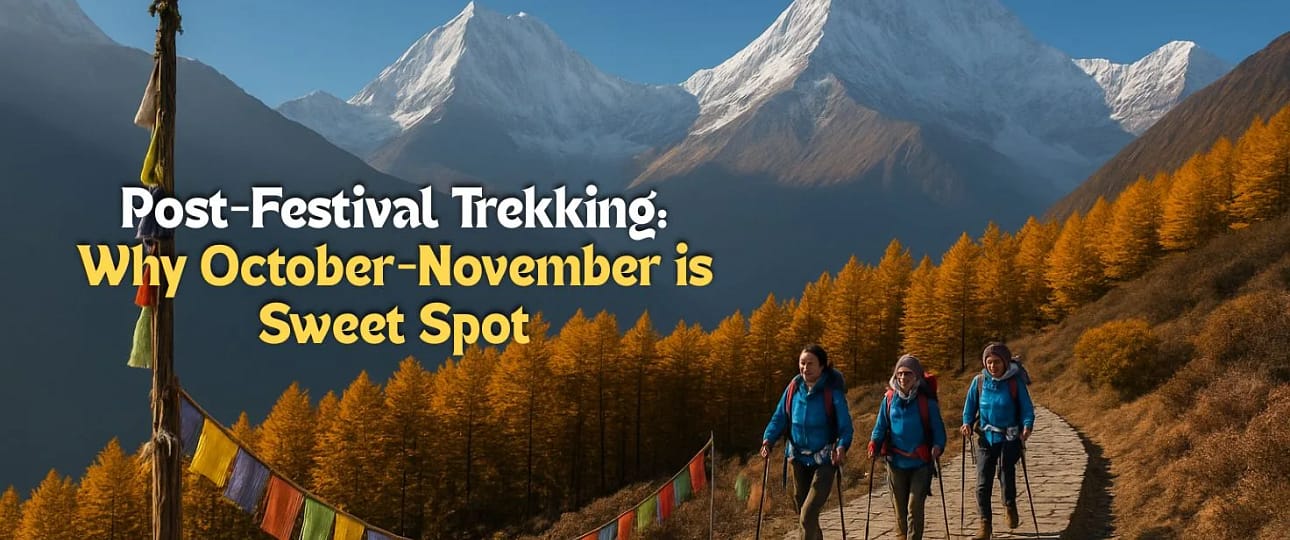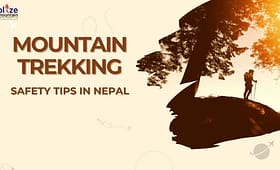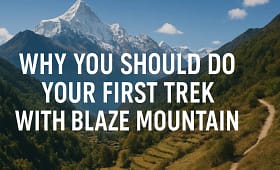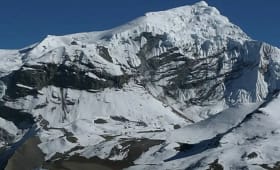Post-Festival Trekking. Alright, let’s talk about something that every serious Nepal trekking enthusiast needs to know but somehow nobody talks about enough – the absolute magic that happens after Dashain and Tihar. You think you know autumn trekking in Nepal? Think again.
Sure, everyone’s obsessed with spring trekking season and all those rhododendron photos flooding Instagram. But here’s the thing – post-festival trekking in October-November is when Nepal’s mountains stop playing games and start showing off for real. We’re talking about the kind of conditions that make you question why you ever bothered trekking anywhere else.
The festivals wrap up, the last of the monsoon rains clear out, and suddenly you’re looking at what might be the most perfect trekking conditions on the planet. No joke – this is when Everest Base Camp trek dreams actually come true, when Annapurna Circuit views blow your mind, and when even a simple Poon Hill trek feels like you’ve stumbled into some kind of mountain paradise.
Crystal Clear Mountain Views: When the Himalayas Show Off
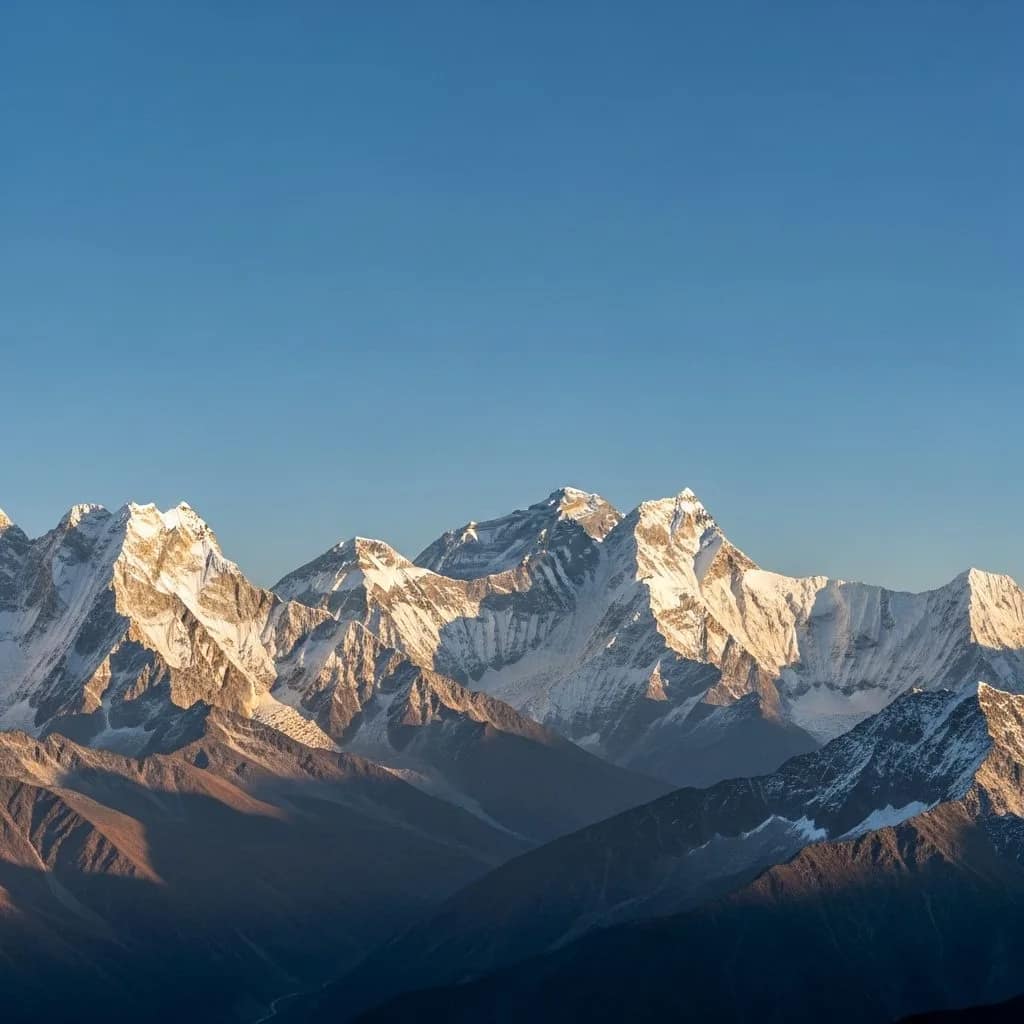
Let’s start with the obvious – the views. Post-monsoon air in Nepal is something else entirely. All that dust and haze that builds up during pre-monsoon season? Gone. The atmospheric crud that makes distant peaks look like fuzzy white bumps? Vanished.
October trekking gives you the kind of mountain visibility that makes your camera work overtime. Mount Everest from Kala Patthar isn’t just a photo op – it’s a religious experience. Annapurna South, Hiunchuli, Machhapuchhre (Fishtail) – these peaks pop out of the landscape with definition so sharp it looks fake.
November trekking keeps the clarity party going. Langtang Lirung from Kyanjin Gompa looks close enough to touch. The Manaslu massif reveals details you never knew existed. Dhaulagiri stops being just another big white mountain and becomes this massive, sculptured masterpiece that dominates the horizon.
The sunrise views during this season? Forget about it. Poon Hill sunrise in post-festival season is what converts casual hikers into hardcore mountain addicts. Everest View Hotel guests during this time see things that make those expensive helicopter rides seem like bargains.
Post-Monsoon Perfect: Dry Trails and Stable Weather
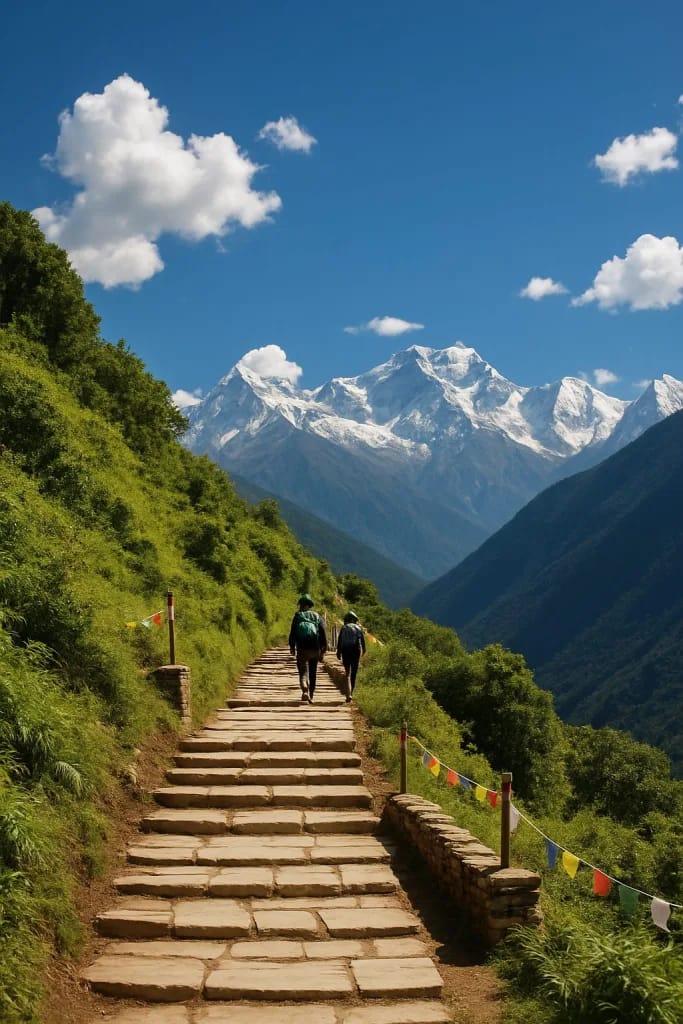
Here’s what nobody tells you about monsoon season – it doesn’t just rain, it destroys trails. Pre-monsoon trekking means dodging landslides, dealing with muddy paths, and basically gambling with weather every single day. But post-monsoon trekking? That’s when trails get back to business.
October weather in the mountains is stupidly reliable. Morning fog burns off by 9 AM, afternoon clouds might roll in for drama but rarely bring serious rain, and evening skies clear up for star-gazing that’ll make you forget your phone exists. Temperature stability means you can actually plan what to pack instead of bringing everything you own.
November conditions maintain that sweet spot between autumn warmth and winter cold. Teahouse temperatures at night are chilly enough to make you appreciate a good sleeping bag, but daytime hiking weather stays comfortable enough that you’re not dying of heatstroke on uphills.
The trail conditions during post-festival trekking are what trail maintenance dreams are made of. Stone steps on the Everest Base Camp route aren’t slippery death traps. Suspension bridges on Annapurna Circuit don’t feel like they’re going to collapse in the wind. Even technical sections on Manaslu Circuit trek become manageable instead of terrifying.
The Festival Hangover Effect: Happy Locals, Better Service
This is where post-Dashain and post-Tihar trekking gets really interesting. Nepal just finished celebrating its biggest festivals. Families have reunited, communities have partied, everyone’s caught up on gossip and good food. The whole country is basically in a collective good mood, and guess what? That translates directly into better trekking experiences.
Lodge owners in places like Namche Bazaar and Manang have just spent weeks with family, celebrating, recharging their batteries. They’re not burned out from months of tourist season stress – they’re refreshed and genuinely happy to see international trekkers again. Dal bhat tastes better when the cook is actually enjoying making it.
Local guides and porters are back from festival holidays with their families. They’ve had time to rest, celebrate, spend money they earned during previous trekking seasons. Sherpa guides returning from Khumbu region family time bring stories, energy, and enthusiasm that you just don’t get during peak exhaustion periods.
Cultural interactions during this time hit different. Village festivals might still be happening in remote areas. Monastery visits feel more authentic because monks aren’t dealing with constant tourist crowds. Local hospitality reaches levels that remind you why Nepal has a reputation for having the friendliest people on earth.
Peak Visibility Season: Photography Dreams Come True
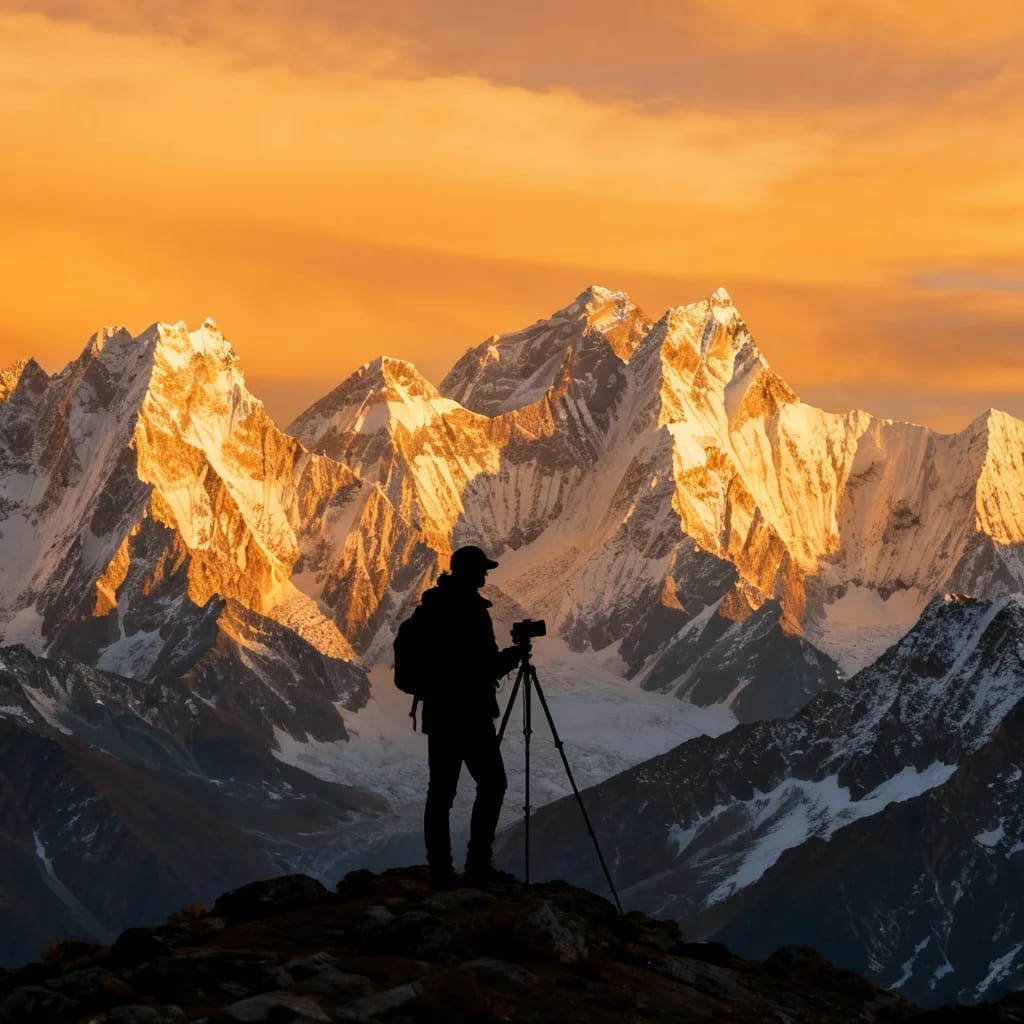
Mountain photography enthusiasts, this section is for you. Post-festival trekking delivers lighting conditions that professional Himalayan photographers plan their entire year around. Atmospheric clarity combined with optimal sun angles creates opportunities that make your Instagram followers hate you.
Golden hour lighting on 8000m peaks during October-November is absolutely unreal. Mount Everest, Lhotse, Makalu – they don’t just catch morning light, they glow like they’re powered by some internal fire. Sunset photography from Everest Base Camp or Annapurna Base Camp during this season produces images that look like they’ve been heavily filtered, except they haven’t.
Mountain reflection photography in high-altitude lakes reaches peak potential. Gokyo Lakes become perfect mirrors reflecting Cho Oyu and surrounding peaks with zero wind distortion. Tilicho Lake turns into a natural photographer’s studio with Annapurna massif reflections so perfect they look computer-generated.
Star photography gets a massive boost from post-monsoon atmospheric conditions. Everest region night skies during this period reveal stars you forgot existed. High-altitude camping on Island Peak or Mera Peak expeditions offers astrophotography opportunities that rival professional observatories.
Comfortable Temperatures: Not Too Hot, Not Too Cold
Temperature management during Nepal trekking can make or break your experience. Too hot, and you’re dying on every uphill. Too cold, and you’re miserable every morning and evening. Post-festival season hits that Goldilocks zone where everything feels just right.
Daytime hiking temperatures in October typically range from 15-20°C (60-70°F) at middle altitudes like Namche Bazaar or Manang. That’s warm enough to hike comfortably in a light shirt, cool enough that you’re not sweating through every layer you brought. Uphill sections don’t become death marches, and rest stops are actually pleasant instead of desperate gasping sessions.
Evening temperatures require a fleece jacket or light down jacket, but nothing extreme. Tea house dining rooms with their yak-dung stoves create cozy atmospheres perfect for dal bhat dinners and local beer. Sleeping bag temperatures are comfortable without requiring arctic-rated gear.
November temperatures shift slightly cooler but maintain that comfortable zone. Morning starts might require gloves and a warm hat, but by mid-morning you’re back to comfortable hiking layers. High-altitude sections like Thorong La Pass on Annapurna Circuit or Cho La Pass on Everest region treks become manageable challenges instead of survival exercises.
Rhododendrons and Alpine Flowers: Nature’s Post-Festival Celebration

Wait, rhododendrons in autumn? Yeah, that’s spring trekking territory, but post-festival season brings its own alpine flower surprises that most people miss because they’re too focused on March-May blooms.
October alpine vegetation in places like Langtang National Park and Sagarmatha National Park shows off colors that rival New England autumn displays. Birch forests turn golden, juniper bushes develop deep purple berries, mountain grasses shift to copper and bronze shades that complement snow-capped peaks perfectly.
High-altitude plant life during post-monsoon season reaches peak survival mode, creating landscapes that look like someone hand-painted them for maximum visual impact. Alpine meadows in Gokyo valley or Annapurna Sanctuary develop color combinations that make regular mountain scenery look boring.
Forest sections on popular routes like Everest Base Camp trek through Sagarmatha National Park offer autumn colors that work as perfect foregrounds for Himalayan peak photography. Pine forests around Tengboche Monastery frame mountain views with seasonal colors that change the entire mood of classic trekking route landscapes.
Less Crowded Trails: Beat the Spring Rush
Here’s something budget trekkers and crowd-avoiding adventure travelers need to understand – post-festival trekking happens before the massive international tourist influx of spring season. October-November is like Nepal’s trekking secret that locals know but foreign tour operators don’t push as hard.
Popular trekking routes during this time see maybe 60% of spring season crowds. Everest Base Camp trek lodge bookings are easier, Annapurna Circuit trail traffic allows for actual conversation and photography stops, Langtang trek feels more like a wilderness experience than a highway march.
Tea house availability improves dramatically. Namche Bazaar lodges aren’t fighting for rooms, Gorak Shep accommodation near Everest Base Camp doesn’t require advance booking months ahead, Manang village stops feeling like a tourist processing center and returns to being an actual Tibetan culture experience.
Guide and porter availability increases significantly. Experienced Sherpa guides who get booked solid during spring climbing season are actually available for autumn trekking. Porter hiring in Lukla or Besisahar doesn’t involve competing with dozens of other trekking groups.
Lodge Availability: No Fighting for Rooms

Tea house trekking during peak seasons can feel like a competitive sport. Room availability becomes a source of stress that ruins the whole mountain experience. Post-festival season eliminates that anxiety completely and lets you focus on why you came – the mountains.
Popular stops like Tengboche, Dingboche, Machhermo on Everest region routes actually have room choices. Single occupancy becomes possible without paying premium rates. Rooms with mountain views don’t get reserved months in advance by guided tour groups.
Annapurna Circuit accommodation stress disappears entirely. Manang acclimatization days don’t involve desperate searches for available beds. Thorong Phedi before the pass crossing has space, meaning you can actually rest properly before the big day instead of sleeping in crowded, stressed conditions.
Food service improves when lodges aren’t overwhelmed. Kitchen staff can focus on quality instead of quantity. Dal bhat gets proper attention, momos are made fresh instead of reheated, local specialties like Sherpa stew or Tibetan bread return to menus that get simplified during peak crowding.
Perfect for First-Time Trekkers: Beginner-Friendly Conditions
First-time Nepal trekkers often get overwhelmed by conflicting advice about best trekking seasons. Post-festival October-November creates ideal conditions for beginner trekkers to fall in love with Himalayan adventures without dealing with extreme challenges.
Weather predictability reduces the anxiety factor that can ruin first trekking experiences. Morning conditions are generally clear, afternoon weather follows predictable patterns, evening temperatures don’t require extreme cold weather gear. Beginner trekkers can focus on enjoying the experience instead of constantly worrying about conditions.
Trail difficulty reaches its most manageable levels. Monsoon damage has been repaired, winter ice hasn’t formed yet, landslide risks are minimal. Popular beginner routes like Ghorepani Poon Hill trek or Everest View trek to Tengboche become accessible to people with moderate fitness levels.
Cultural comfort for first-time visitors improves significantly. Local interactions are more relaxed, lodge atmospheres are welcoming rather than rushed, guide availability means better cultural interpretation and safety support. Nepal trekking stops being intimidating and becomes inspiring.
Tea House Culture at Its Best: Cozy Evenings and Warm Hospitality
Tea house culture is what separates Nepal trekking from wilderness camping adventures elsewhere. Post-festival season showcases this culture at its absolute peak, when mountain hospitality reflects genuine warmth rather than exhausted service industry professionalism.
Evening gatherings in tea house dining rooms during October-November feel like joining extended family dinners. Lodge owners have time for conversations about local life, mountain conditions, cultural traditions. Yak-dung stoves create gathering spaces where international trekkers, local staff, and traveling traders share stories and local legends.
Traditional foods get proper preparation time. Dal bhat variations reflect regional specialties – Sherpa dal bhat in Khumbu region, Gurung preparations in Annapurna area, Tamang influences in Langtang valley. Local beverages like chang (barley beer) and raksi (local spirits) appear on menus when lodge owners aren’t overwhelmed with basic service demands.
Cultural education happens naturally during post-festival tea house stays. Buddhist prayer ceremonies in mountain monasteries welcome respectful observers. Local festivals in remote villages might still be celebrating post-Tihar events. Traditional music and folk songs emerge during evening gatherings when communities feel relaxed and celebratory.
The Acclimatization Advantage: Perfect Timing for High Altitude
High-altitude trekking success depends heavily on acclimatization timing and weather stability. Post-festival season offers ideal conditions for altitude adjustment that make technical peak climbing and high pass crossings more achievable for regular adventure travelers.
Stable barometric pressure during October-November reduces altitude sickness variability. Weather consistency means acclimatization days in places like Namche Bazaar, Manang, or Pheriche can focus on gradual altitude gain instead of dealing with storm systems and temperature extremes.
High-altitude destinations like Everest Base Camp (5,364m), Annapurna Base Camp (4,130m), Tilicho Lake (4,919m) become more accessible when weather conditions support proper acclimatization schedules. Rest days serve their intended purpose instead of becoming weather-waiting exercises.
Technical pass crossings like Thorong La (5,416m), Cho La (5,420m), Renjo La (5,360m) benefit from stable conditions that reduce safety risks and timing pressure. Early morning starts happen in clear conditions instead of storm uncertainty, making these bucket-list achievements more attainable for average fitness trekkers.
Bottom Line: October-November is Nepal’s Trekking Sweet Spot
Here’s the reality check – post-festival trekking in October-November offers the most consistently excellent Nepal trekking conditions of the entire year. Weather stability, cultural warmth, crowd management, lodge availability, trail conditions – everything aligns to create trekking experiences that exceed expectations instead of just meeting them.
Spring season gets all the marketing hype because rhododendron blooms photograph well and March-May fits international vacation schedules. But autumn trekking after Dashain and Tihar delivers superior mountain experiences for people who prioritize actual trekking quality over Instagram opportunities.
Everest Base Camp dreams, Annapurna Circuit adventures, Langtang explorations, Manaslu challenges – they all reach their peak potential during post-festival season. Mountain views are clearer, local interactions are warmer, weather conditions are more reliable, cultural experiences are more authentic.
The mountains will always be there, but perfect trekking conditions only happen when weather, culture, and timing align. October-November after Nepal’s biggest festivals creates that alignment better than any other time of year. Adventure travelers who understand this timing get Nepal trekking experiences that convert them into lifelong Himalayan addicts.
Stop planning your Nepal adventure around everyone else’s schedule. Post-festival trekking season is when the mountains show their best side, when local culture shines brightest, when trekking conditions reach peak perfection. This is Nepal’s sweet spot the season when everything that makes Himalayan trekking legendary comes together in perfect harmony.

